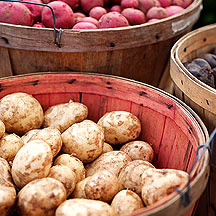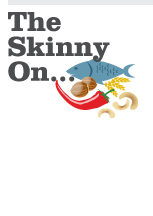From blue to red to white to yellow, we’ve got the lowdown on potatoes. Here’s how to buy, store, cook and enjoy this versatile vegetable.


And no wonder. The fat-free, sodium-free, cholesterol-free potato is incredibly nutritious. A medium-size potato (5.3 ounces, about the size of a computer mouse) has half your day’s vitamin C requirement. If eaten with its skin, a potato has more potassium than a banana and is one of the best fiber options in the produce section.
Basic varieties
There are five basic types: yellow-fleshed, red-skinned, white, blue and Russet. They are categorized by color and by starch: less starch yields a firmer potato. Here’s the complete run-down:
Nutrition
Contrary to popular myth, most of the potato’s vitamins and minerals are not found in the skin. Instead, they cluster in a layer a little less than an inch under the skin. Therefore, removing the skin will not affect the spud’s nutrition. However, it will reduce its fiber and potassium content.
Best-ever mashed potatoes
Here’s a shock: the microwave actually makes the best mashed potatoes.
1. Wash (but do not dry) 4 or 5 medium Russet or yellow-fleshed potatoes. Do not prick or peel them. Place them in a large, microwave-safe bowl with a lid that has an open vent hole — or cover the microwave-safe bowl with plastic wrap and then poke a small hole in the wrap.
2. Microwave on high for 8 minutes (total) without disturbing.
3. Remove from microwave — be careful of hot steam — take off the lid or plastic wrap, and mash with an electric mixer at medium speed or a hand-held potato masher adding some skim milk, fat-free chicken or vegetable broth, a little butter or olive oil and/or some Dijon mustard and herbs.
| The Potato Rainbow | |||
|---|---|---|---|
| Yellow-fleshed These dense, creamy potatoes, typified by the Yukon Gold variety, are moderately starchy, and so make excellent mashed potatoes and au gratins. They are flavorful, slightly sweet and perfect for steaming, boiling, stir-frying and pan-frying (as in hashed browns or hash). | |||
| Red-skinned Often called “new potatoes,” these spuds have a vibrant red skin — and some, a mottled red skin. They have a mild, earthy taste and are the least starchy of any variety, so they’re best roasted with olive oil and herbs. Because they hold up well, they’re also great in potato salads. | |||
| White potatoes Perhaps the most versatile potato, these are available in round little balls or long fingerlings (not named for fingers but for little German fish). They should not be confused with larger Russets; white potatoes, like Irish creamers, are always small with a creamy white or pale beige skin. Use them for salads, mashed potatoes, oven fries and any dish that requires boiled or steamed potatoes. | |||
| Blue potatoes Closely related to the original potatoes from South America, blues are actually available in a range of colors: blue, violet, purple or lavender. These fairly starchy potatoes have a nutty, earthy taste. They are good roasted or mixed into doughs (bread, muffin or even tamale). | |||
| Russets Sometimes called Idaho or baking potatoes, Russets are the starchiest (and thus the fluffiest) potatoes and have thick, netted-brown skins. They make fluffy mashed potatoes and classic baked potatoes as well as great French fries. Their skin is so thick and chewy that these are the only potatoes that can be turned into potato skins. Because of their dry, starchy texture, they are also the only potatoes that can create gnocchi or potato noodles. |
No comments:
Post a Comment